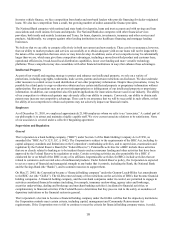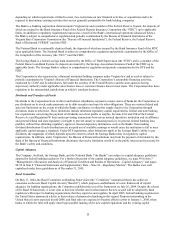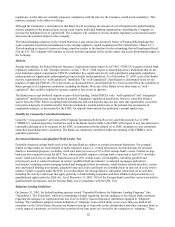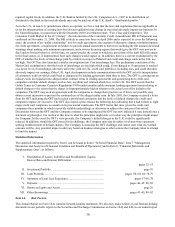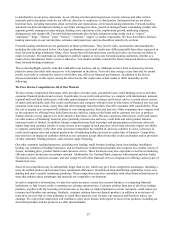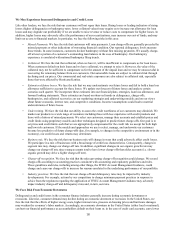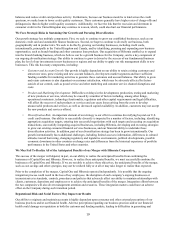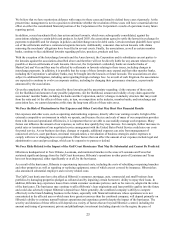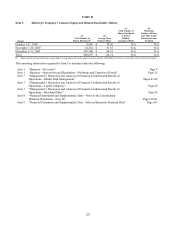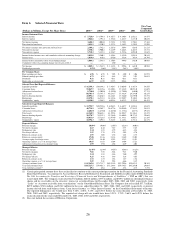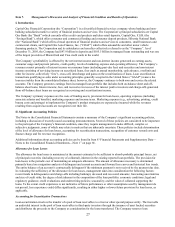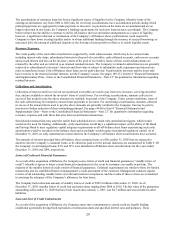Capital One 2005 Annual Report Download - page 29
Download and view the complete annual report
Please find page 29 of the 2005 Capital One annual report below. You can navigate through the pages in the report by either clicking on the pages listed below, or by using the keyword search tool below to find specific information within the annual report.maintaining accounts as well as in financing them. Adverse developments with respect to the consumer or other external
perceptions regarding the practices of our competitors, or our industry as a whole, may also adversely impact our reputation.
In addition, adverse reputational impacts on third parties with whom we have important relationships, such as our
independent auditors, may also adversely impact our reputation. Adverse impacts on our reputation, or the reputation of our
industry, may also result in greater regulatory and/or legislative scrutiny, which may lead to laws or regulations that may
change or constrain the manner in which we engage with our customers and the products we offer them. Adverse reputational
impacts or events may also increase our litigation risk. See “We Face the Risk of a Complex and Changing Regulatory and
Legal Environment” below. To this end, we carefully monitor internal and external developments for areas of potential
reputational risk and have established governance structures to assist in evaluating such risks in our business practices and
ecisions. d
In addition, a variety of social factors may cause changes in credit card and other consumer finance use, payment patterns and
the rate of defaults by accountholders and borrowers. These social factors include changes in consumer confidence levels, the
public’ s perception of the use of credit cards and other consumer debt, and changing attitudes about incurring debt and the
stigma of personal bankruptcy.
We Face Risk Related to the Strength of our Operational, Technological and Organizational Infrastructure
Our ability to grow and compete is dependent on our ability to build or acquire the necessary operational and technological
infrastructure and to manage the cost of that infrastructure while we expand. Similar to other large corporations, in our case,
operational risk can manifest itself in many ways, such as errors related to failed or inadequate processes, faulty or disabled
computer systems, fraud by employees or persons outside of Capital One and exposure to external events. We are dependent
on our operational infrastructure to help manage these risks. In addition, we are heavily dependent on the strength and
capability of our technology systems which we use both to interface with our customers and to manage our internal financial
and other systems. Our ability to develop and deliver new products that meet the needs of our existing customers and attract
new ones depends on the functionality of our technology systems. Our ability to develop and implement effective marketing
campaigns also depends on our technology. Additionally, our ability to run our business in compliance with applicable laws
and regulations is dependent on these infrastructures.
We continuously monitor our operational and technological capabilities and make modifications and improvements when we
believe it will be cost effective to do so. In some instances, we may build and maintain these capabilities ourselves. We also
outsource some of these functions to third parties. These third parties may experience errors or disruptions that could
adversely impact us and over which we may have limited control. As we increase the amount of our infrastructure that we
outsource to third parties, we increase our exposure to this risk. We also face risk from the integration of new infrastructure
platforms and/or new third party providers of such platforms into our existing businesses. We are currently undertaking a
project with Total System Services, Inc. (“TSYS”) to transfer to a new technological platform that will result in TSYS
providing processing services for Capital One’ s North American portfolio of consumer and small business credit card
accounts. Our ability to successfully transition to this new platform as well as TSYS’ s ongoing ability to provide services to
s, could impact our performance in the future. u
In addition to creating a solid infrastructure platform, we are also dependent on recruiting management and operations
personnel with the experience to run an increasingly large and complex business. Although we take steps to retain our
existing management talent and recruit new talent as needed, we face a competitive market for such talent and there can be no
assurance that we will continue to be able to maintain and build a management team capable of running our increasingly
rge and complex business. la
We May Face Limited Availability of Financing, Variation in Our Funding Costs and Uncertainty in Our
Securitization Financing
In general, the amount, type and cost of our funding, including financing from other financial institutions, the capital markets
and deposits, directly impacts our expense in operating our business and growing our assets and therefore, can positively or
egatively affect our financial results. n
A number of factors could make such financing more difficult, more expensive or unavailable on any terms both
domestically and internationally (where funding transactions may be on terms more or less favorable than in the United
States), including, but not limited to, financial results and losses, changes within our organization, specific events that
adversely impact our reputation, changes in the activities of our business partners, disruptions in the capital markets, specific
events that adversely impact the financial services industry, counter-party availability, changes affecting our assets, our
corporate and regulatory structure, interest rate fluctuations, ratings agencies actions, and the legal, regulatory, accounting
and tax environments governing our funding transactions. In addition, our ability to raise funds is strongly affected by the
general state of the U.S. and world economies, and may become increasingly difficult due to economic and other factors.
20


